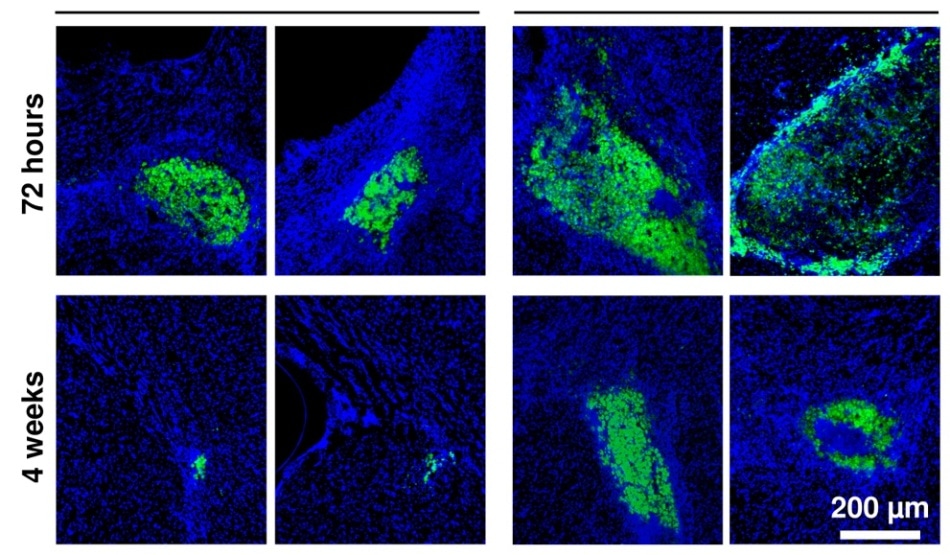Nov 15 2018
A research team from the Centre for Biomedical Technology (CTB) at Universidad Politécnica de Madrid (UPM), in association with the Universidad Complutense de Madrid (UCM), the Hospital Clínico San Carlos, and the Instituto Cajal, has devised a new treatment for repairing damaged brain tissues.
 Fluorescence microscopy images showing stem cells (green) implanted in a brain tissue (blue). The four figures at the right show the survival of non-encapsulated stem cells, and the figures at the right show the silk fibroin hydrogels-encapsulated stem cells. (Image credit: Front Cell Neurosci. 2018 Sep 6;12:296. doi: 10.3389/fncel.2018.00296)
Fluorescence microscopy images showing stem cells (green) implanted in a brain tissue (blue). The four figures at the right show the survival of non-encapsulated stem cells, and the figures at the right show the silk fibroin hydrogels-encapsulated stem cells. (Image credit: Front Cell Neurosci. 2018 Sep 6;12:296. doi: 10.3389/fncel.2018.00296)
The implantation of encapsulated stem cells in a fully biocompatible (silk fibroin) and a non-toxic biomaterial allowed the scientists to achieve the functional recovery of mice that were suffering from an induced brain stroke.
This encapsulation has the potential to boost the survival rate of stem cells embedded in the brain, and besides having a positive effect on the repair of damaged nerve tissue, it can also prevent the degree of the damage.
Permanent cognitive and physical disabilities can be caused by various neurological disorders. The human nervous system has a reduced capacity to recover following an injury, for example, after a brain trauma or stroke. However, the same limited capacity is seen in patients suffering from neurodegenerative diseases like Parkinson’s or Alzheimer’s in which the brain undergoes a progressive deterioration.
Stem cell therapies—considering its therapeutic potential to repair and protect the damaged brain—are shown to be a promising treatment for these types of diseases. Yet, the stem cell transplant comes with its own challenges, among others, such as reduced survival rate in the brain following transplant. This poses an obstacle to achieve the most appropriate treatment.
To overcome this obstacle, a team headed by scientists from the Centre for Biomedical Technology, in association with UCM, the Hospital Clínico San Carlos, and the Instituto Cajal, has come up with a novel bioengineering method to repair the damaged tissues in the brain. To accomplish this feat, the scientists first implanted mesenchymal stem cells in mice with infarct brain enclosed in a fully biocompatible silk fibroin and a non-toxic biomaterial.
Post the treatment, the mice showed a substantial improvement in their motor and sensory skills, which had been extremely modified after the stroke. In addition, the researchers used electrophysiological methods to demonstrate the enhancement of brain reorganization in neighboring areas to the damaged zone. Another pertinent aspect of this study was that silk fibroin significantly boosted the survival of stem cells embedded in the brain, obviating the extent of the damage after the induced brain stroke in mice.
These results are a step forward in new treatments of neurologic disorders when using silk fibroin as a drug delivery vehicle, achieving a higher therapy performance and the functional improvement of patients.
Daniel González Nieto, Researcher, Centre for Biomedical Technology, Universidad Politécnica de Madrid.
The research was supported by the Community of Madrid via the NeuroCentro project (B2017/BMD-3760), an initiative to create a new technological center in the Madrid region for the integrated treatment of neurologic disorders. The research was also funded by the Ministry of Economy and Competitiveness (MAT2016-79832-R, MAT2016-79832-R y MAT2015-66666-C3-3-R projects). UPM spin-off company, Silk Biomed, was also involved in this project. UPM is a pioneer in the development of a wide range of sophisticated medical products made of silk fibroin for the treatment of various neurologic disorders.